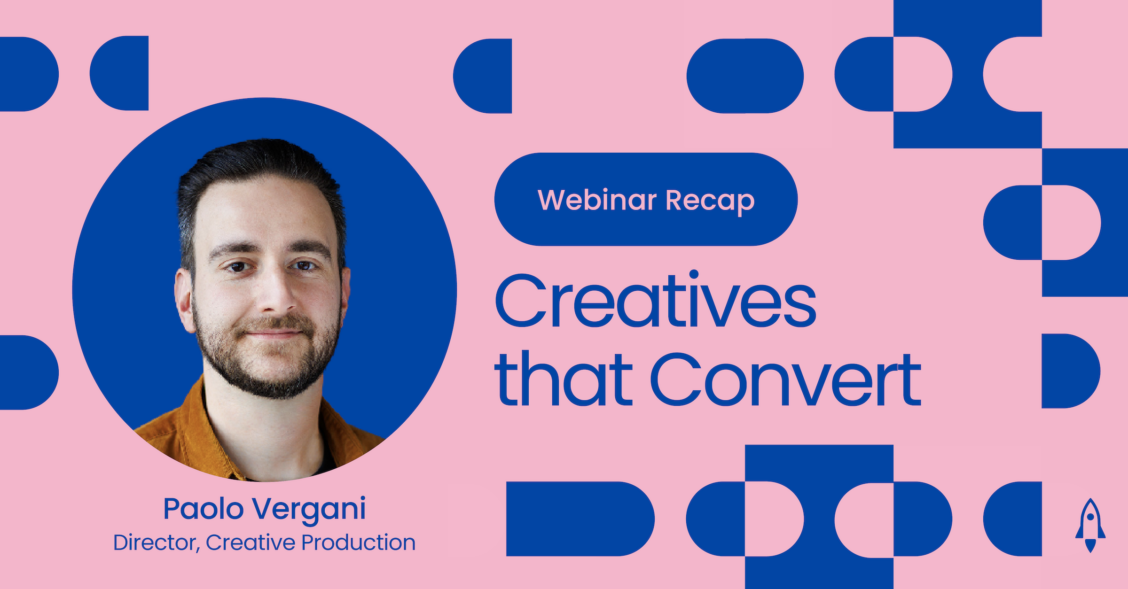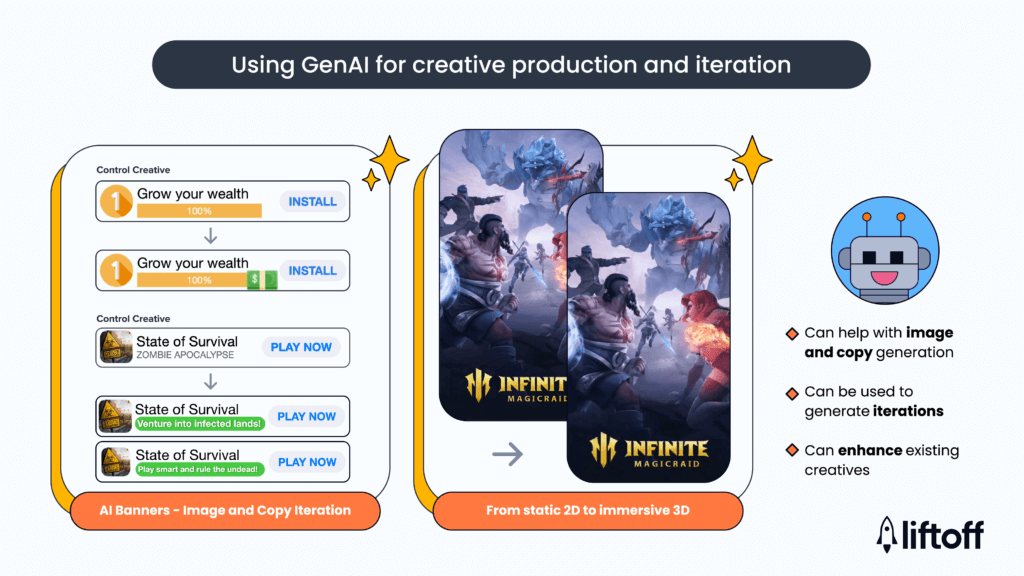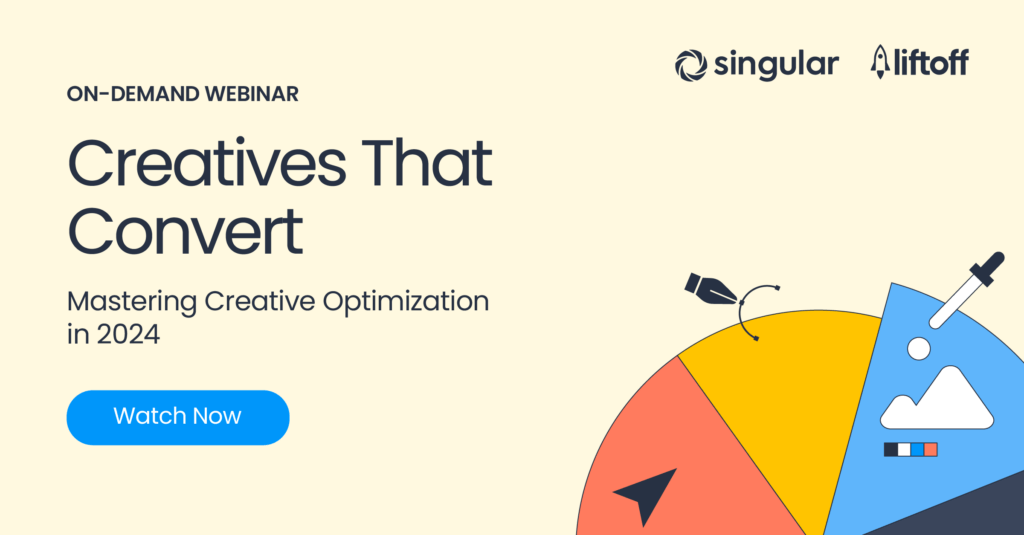
Mastering Ad Creative in 2024: Optimizing, Testing, Generative AI, and Key Trends
There’s no overstating the importance of ad creative in mobile marketing success. But nailing those “unicorn” creatives isn’t as easy as it seems. You can spend as much time in creative voids where the right answer seems so far away.
Of course, creative has always been important. But in 2024, with tightening budgets, cutbacks, and the growing popularity of generative AI changing workflows and outputs, getting your creative right has never been more important.
That said, creative works at its best when you know how to test and iterate. Effective creative doesn’t work in a silo. You also need to understand how to measure and optimize creative assets, and the most effective formats for boosting conversion rates. Only then can you realize the true potential of your creative.
Paolo Vergani, Liftoff’s Director of Creative Production, has a lot of experience doing all of the above. He recently joined an all-star lineup of app marketers as part of a Singular webinar on optimizing mobile ad creative. You can watch the full recording here, but if you’re in a hurry, we’ve compiled a condensed creative optimization guide featuring some of the key takeaways Paolo shared in the webinar.
How Generative AI can bolster mobile ad creative
Generative AI has developed rapidly over the past few years, and many of us are now wondering how we can use this powerful new technology to streamline our workflows and strengthen our strategies. During the webinar, Vergani discussed ways Liftoff’s Creative Studio has used Gen AI to supercharge creatives, mainly through image and copy generation.

For example, in one banner creative designed to promote a post-apocalyptic zombie game, Generative AI suggested changing the phrase “Zombie Apocalypse” to “Play smart and rule the undead!”—a clearer call to action that would resonate better with the target audience. Vergani also showed how AI tools can improve existing creative content, such as by bringing a static ad to life by adding a 3D parallax effect.
He said: “AI can also be used for localization. Not only can it translate text, but it can localize the actual voice of the actors and creators you’re using into different languages and lip-sync accordingly. The quality and accuracy of these tools are highly impressive. I feel like there are no excuses now for not having fully localized creatives in your campaigns.”
The most innovative mobile ad formats today
Vergani also highlighted the most innovative mobile ad formats and discussed how these might evolve in the near future. He noted that video was by far the most common ad format in 2023 but that long-form video ads (those longer than 45 seconds) have seen significant growth, while short-form had shrunk in comparison.
He said: “When talking about long-form video, one of the first questions I always get asked is ‘What about the user experience? Are users trapped in longer ads?’ The answer is no, not at all. For both skippable and rewarded ads, the close button settings are the same as for shorter videos. That means that if a user is interested in the content and doesn’t want to close the ad, they can get more of it, resulting in higher conversion rates.
“Another new format that we’re seeing is triple-page ad experiences. These creatives give advertisers a way of combining the best aspects of video, interactive or playables, and static ads into a single ad experience. These are great because they offer the opportunity to tell a compelling and cohesive story across the ad. So, you can have a video and then something from that gets transported into a playable. You get to develop the story in the playable and then have a final static end card to pull it all together.”
Vergani noted that there have been significant changes to the state of user-generated content (UGC), too: “UGC is moving out of social media platforms and expanding to ad networks. There are a lot of benefits to implementing UGC. It helps create social proof by showing real users. It allows you to hone on a demographic or emotional appeal. And finally, it helps combat creative fatigue as it increases IPMs (installs per mille).”
The 4 phases of iterative testing
Another key point that Vergani touched on was iterative testing and how it should be a continuous part of the ad creative process to foster a data-driven approach to design. While that might sound like an enormous task, it can be broken down into four distinct phases:
- Phase one – Strategy: This is where you combine all your research, competitor analysts, and industry insights to devise a plan. You should also gather performance data to hypothesize what might drive the most performance from your campaigns.
- Phase two – Ideation: This is where you find multiple directions to take that hypothesis and prioritize the highest impact ideas into production, which is the third phase.
- Phase three – Production: Once your ads are in production, you can utilize performance data to ensure that only the best ad formats and concepts are used going forward.
- Phase four – Optimization: Now that you’ve got your winning ad concepts and formats, all that’s left to do is iterate and use these concepts and formats to inform future ad strategies.
Key trends in 2024
Trends come and go in mobile marketing, but one thing that will never change is the importance of testing, whether that’s creative testing or taking your concepts and experimenting with longer durations across different ad formats.
“Iterative testing is the key to unlocking creative performance,” says Vergani, which comes down to “testing different concepts, finding the ones that work, and then iterating to fine-tune the content.”
Finally, generative AI isn’t going anywhere. Sure, learning how to get the most out of AI might take some time, but app marketers should embrace generative AI rather than see it as a hindrance. By understanding how AI can benefit ad creative, whether speeding up creative conceptualization or empowering non-creatives to make design tweaks, generative AI tools can improve ad conversation rates when used effectively.
“AI is here to stay, and we need to implement it in our creative strategy in ways that support the creative work and make our lives easier, as well as our creative better,” Vergani says.
